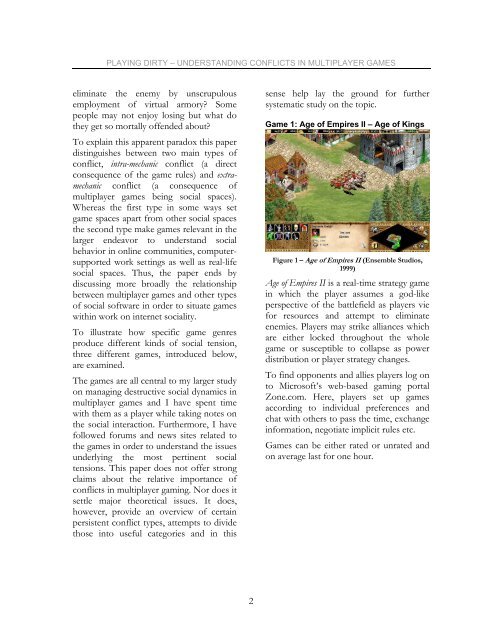Playing Dirty â Understanding Conflicts In Multiplayer Games
Playing Dirty â Understanding Conflicts In Multiplayer Games
Playing Dirty â Understanding Conflicts In Multiplayer Games
You also want an ePaper? Increase the reach of your titles
YUMPU automatically turns print PDFs into web optimized ePapers that Google loves.
PLAYING DIRTY – UNDERSTANDING CONFLICTS IN MULTIPLAYER GAMES<br />
eliminate the enemy by unscrupulous<br />
employment of virtual armory? Some<br />
people may not enjoy losing but what do<br />
they get so mortally offended about?<br />
To explain this apparent paradox this paper<br />
distinguishes between two main types of<br />
conflict, intra-mechanic conflict (a direct<br />
consequence of the game rules) and extramechanic<br />
conflict (a consequence of<br />
multiplayer games being social spaces).<br />
Whereas the first type in some ways set<br />
game spaces apart from other social spaces<br />
the second type make games relevant in the<br />
larger endeavor to understand social<br />
behavior in online communities, computersupported<br />
work settings as well as real-life<br />
social spaces. Thus, the paper ends by<br />
discussing more broadly the relationship<br />
between multiplayer games and other types<br />
of social software in order to situate games<br />
within work on internet sociality.<br />
To illustrate how specific game genres<br />
produce different kinds of social tension,<br />
three different games, introduced below,<br />
are examined.<br />
The games are all central to my larger study<br />
on managing destructive social dynamics in<br />
multiplayer games and I have spent time<br />
with them as a player while taking notes on<br />
the social interaction. Furthermore, I have<br />
followed forums and news sites related to<br />
the games in order to understand the issues<br />
underlying the most pertinent social<br />
tensions. This paper does not offer strong<br />
claims about the relative importance of<br />
conflicts in multiplayer gaming. Nor does it<br />
settle major theoretical issues. It does,<br />
however, provide an overview of certain<br />
persistent conflict types, attempts to divide<br />
those into useful categories and in this<br />
sense help lay the ground for further<br />
systematic study on the topic.<br />
Game 1: Age of Empires II – Age of Kings<br />
Figure 1 – Age of Empires II (Ensemble Studios,<br />
1999)<br />
Age of Empires II is a real-time strategy game<br />
in which the player assumes a god-like<br />
perspective of the battlefield as players vie<br />
for resources and attempt to eliminate<br />
enemies. Players may strike alliances which<br />
are either locked throughout the whole<br />
game or susceptible to collapse as power<br />
distribution or player strategy changes.<br />
To find opponents and allies players log on<br />
to Microsoft’s web-based gaming portal<br />
Zone.com. Here, players set up games<br />
according to individual preferences and<br />
chat with others to pass the time, exchange<br />
information, negotiate implicit rules etc.<br />
<strong>Games</strong> can be either rated or unrated and<br />
on average last for one hour.<br />
2



